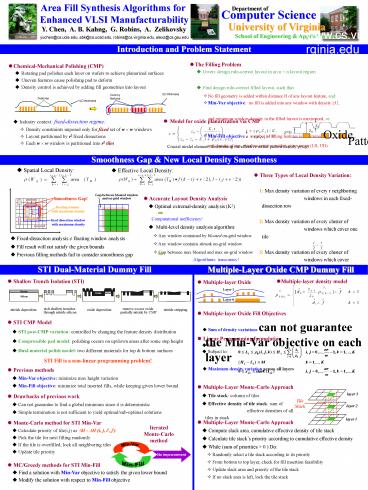STI CMP Model - PowerPoint PPT Presentation
1 / 1
Title:
STI CMP Model
Description:
Area Fill Synthesis Algorithms for Enhanced VLSI Manufacturability Department of Computer Science University of Virginia Y. Chen, A. B. Kahng, G. Robins, A. Zelikovsky – PowerPoint PPT presentation
Number of Views:55
Avg rating:3.0/5.0
Title: STI CMP Model
1
Area Fill Synthesis Algorithms for Enhanced VLSI
Manufacturability
Department of
Computer Science
University of Virginia
Y. Chen, A. B. Kahng, G. Robins, A. Zelikovsky
School of Engineering Applied Science
yuchen_at_cs.ucla.edu, abk_at_cs.ucsd.edu,
robins_at_cs.virginia.edu, alexz_at_cs.gsu.edu
Introduction and Problem Statement
www.cs.virginia.edu/robins
- The Filling Problem
- Given design rule-correct layout in an n n
layout region - Find design rule-correct filled layout, such
that - No fill geometry is added within distance B of
any layout feature, and - Min-Var objective no fill is added into any
window with density ?U, - and minimum window density in the filled layout
is maximized, or - Min-Fill objective number of filling features is
minimized, - and density of any window remains within given
range (LB, UB)
- Chemical-Mechanical Polishing (CMP)
- Rotating pad polishes each layer on wafers to
achieve planarized surfaces - Uneven features cause polishing pad to deform
- Density control is achieved by adding fill
geometries into layout
ILD thickness
Dummy features
Features
ILD thickness
- Model for oxide planarization via CMP
- Industry context fixed-dissection regime
- Density constraints imposed only for fixed set
of w ? w windows - Layout partitioned by r2 fixed dissections
- Each w ? w window is partitioned into r2 tiles
z1
Oxide
z0
z0
Pattern
Crucial model element determining the effective
initial pattern density ?(x,y)
Smoothness Gap New Local Density Smoothness
- Spatial Local Density
- Effective Local Density
- Three Types of Local Density Variation
- 1 Max density variation of every r neighboring
windows in each fixed-dissection row - 2 Max density variation of every cluster of
windows which cover one tile - 3 Max density variation of every cluster of
windows which cover tiles
Gap between bloated window and on-grid window
- Accurate Layout Density Analysis
- Optimal extremal-density analysis (K2)
- Computational inefficiency!
- Multi-level density analysis algorithm
- Any window contained by bloated on-grid window
- Any window contains shrunk on-grid window
- Gap between max bloated and max on-grid window
Algorithmic inaccuracy!
Smoothness Gap!
floating window with maximum density
fixed dissection window with maximum density
- Fixed-dissection analysis ? floating window
analysis - Fill result will not satisfy the given bounds
- Previous filling methods fail to consider
smoothness gap
STI Dual-Material Dummy Fill
Multiple-Layer Oxide CMP Dummy Fill
- Multiple-layer density model
- Multiple-layer Oxide
- Shallow Trench Isolation (STI)
Layer 1
Layer 0
nitride deposition
etch shallow trenches through nitride silicon
oxide deposition
remove excess oxide partially nitride by CMP
nitride stripping
- Multiple-layer Oxide Fill Objectives
- Sum of density variations can not guarantee the
Min-Var objective on each layer - Maximum density variation across all layers
- STI CMP Model
- STI post-CMP variation controlled by changing
the feature density distribution - Compressible pad model polishing occurs on
up/down areas after some step height - Dual-material polish model two different
materials for top bottom surfaces
- Linear Programming formulation
- Min M
- Subject to
STI Fill is a non-linear programming problem!
- Previous methods
- Min-Var objective minimize max height variation
- Min-Fill objective minimize total inserted
fills, while keeping given lower bound
- Multiple-Layer Monte-Carlo Approach
- Tile stack column of tiles
- Effective density of tile stack sum of
effective densities of all tiles in stack
layer 3
- Drawbacks of previous work
- Can not guarantee to find a global minimum since
it is deterministic - Simple termination is not sufficient to yield
optimal/sub-optimal solutions
Tile Stack
layer 2
layer 1
- Monte-Carlo method for STI Min-Var
- Calculate priority of tile(i,j) as ?H - ?H (i,
j, i, j) - Pick the tile for next filling randomly
- If the tile is overfilled, lock all neighboring
tiles - Update tile priority
- Multiple-Layer Monte-Carlo Approach
- Compute slack area, cumulative effective density
of tile stack - Calculate tile stacks priority according to
cumulative effective density - While (sum of priorities gt 0 ) Do
- Randomly select a tile stack according to its
priority - From bottom to top layer, check for fill
insertion feasibility - Update slack area and priority of the tile stack
- If no slack area is left, lock the tile stack
Iterated Monte-Carlo method
Min-Var
No Improvement
Min-Fill
- MC/Greedy methods for STI Min-Fill
- Find a solution with Min-Var objective to
satisfy the given lower bound - Modify the solution with respect to Min-Fill
objective































